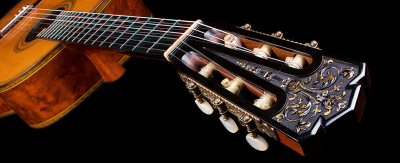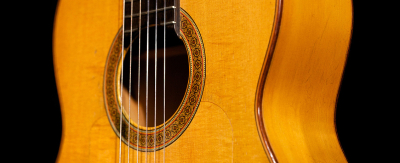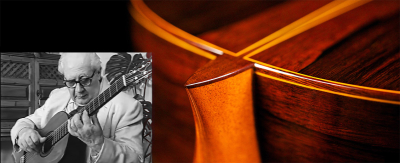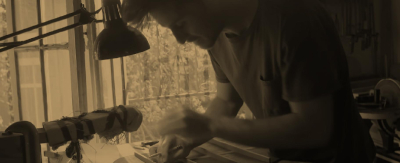The Ramirez Family: Masters of the Guitar
Current Inventory | Past Inventory
The Ramirez Family: Masters of the Guitar
text by Marco Bazzotti photos from the Ramirez archive
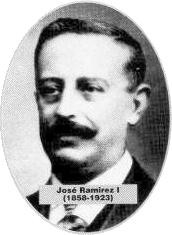
The great adventure of the Spanish ancient luthier dynasty. The protagonists, the techniques and the secret of a legend born in Madrid more than one hundred years ago. Here the history of their success.
Beautiful, elegant and thoroughly Spanish. A dream for the passionate and a virtual necessity for the musician that performs in public. Thanks to the high standards of construction and to the adherence to traditional techniques it has been able to conquer a corner of the market, making it the envy of many other brands. We are speaking of the Ramirez guitar. If the cliche “Spanish guitar” has become inseparable with the six-stringed instrument, enlivening a two-word phrase with historical significance, comparable to the phrases “Neapolitan mandolin” or “French horn”, it is even more valid for guitarists to speak of the dynasty of the guitarreros Ramirez, a name that for more than a century has been the exemplar for the most prestigious signatures in guitar construction.
Ramirez’ guitars have contributed to increasing the prestige and universal approval of the classical guitar and supporting its entry into the Recital Hall, as well as becoming prized museum pieces. Ramirez’ great historical worth is in having built at just the right time an instrument that has served as a reference for at least a couple of generations of guitar makers. At his school dozens of artisans have been educated who, in succession, have given life to their own products. The Ramirez guitar has become the most imitated and discussed guitar of our century, a model to be copied, studied and compared by guitar makers and interpreters. Great soloists like Andrés Segovia, Christopher Parkening, Oscar Ghiglia, Kazuhito Yamashita and Maurizio Colonna have added to its mystique.
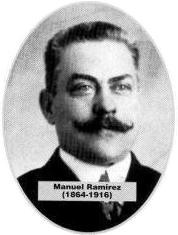
The organization of the Ramirez workshop is based on the tradition of the workshops of the ancient guilds of artisans, with their marked differentiation into the three categories of “apprentices,” “journeymen” and “maestros (masters).” The relationship of the first two categories to the maestros of the Ramirez guitar workshop was one of economic, social and even moral dependency, with the characteristics of a sort of vassalage. According to tradition the mission of teaching, checking and correcting, with severity as was necessary, was the role of the maestro. The maestro is a kind of director of the works, who transmits his experience and passes on the secrets of the workshop; supervises the work; and creates new models.
On the other hand any luthier’s shop using traditional construction develops its own particular techniques for dealing with the various musical and technical/performance demands. Even the splendid work of Don Anthony Torres Jurado (1817-1892), who was the leading craftsman of what scholars refer to as the “third renaissance” of the guitar, would have achieved only local fame and amateur status, had not a new and stronger tradition, specifically that established by the Ramirez household, made its way to the forefront of countries in at least three continents (Europe, South America, Russia and Japan).
The Family Saga
The history of the Ramirez family of Madrid has been told to us directly by José Pepe Ramirez III, in articles in his book, En torno a la guitarra (translated into English as “Things About the Guitar”, published in 1993 and having become, since the death of the great guitar maker two years ago, his spiritual will). It can be argued that José Pepe himself is the most innovative maker of the family. No other family member was as persistent in research and experimentation and active in sharing his results.
The founder of the family was José I Ramírez, first-born child of this José Ramírez de Galarreta, a very well-off land owner. By 1870 the young José had chosen to complete his apprenticeship in the guitar workshop of Francisco Gonzalez (1830-1880). After a dozen years José I was able independently to found his first workshop in Madrid, at El rastro. The workshp was then moved in 1890 to Concepción Jeronima 2, the same street in which his descendants are still working today. Of his three brothers, only the youngest preferred the sure career of rancher; Manuel, who was born in 1864 in Alhame de Aragon, followed José I in guitar making, an enterprise belabored by a low market for its products and threatened with extinction. ” If a guitar maker did not die in a social welfare hospital, it was because he did not have the means to get there ” the elder José used to say to his child José II, who was born in 1885.
Manuel was indeed a restless character. He started three different workshops in Madrid; he was able to produce equally well folk or classical guitars, for which he received the praises of Francisco Tárrega and also violins (the only family member to do so), becoming official Luthier of the Royal Conservatory of Madrid. Recognitions for his work began to arrive steadily, including the medal at the Chicago Fair in 1893. His brother was willing to help set him up in a workshop in another country, but Manuel preferred to try his fortune alone, opening a competing workshop in Madrid, at Cava Baja 24. Thus was born a tenacious antagonism between the two brothers that plagued them until the end of their days, with several tense episodes.
The Meeting With Andres Segovia
José I create the socalled tablao, a flamenco guitar with a large body but narrow widths of the sides to acquire a more ample volume of sound. But that model had only a few years of glory before Manuel was able to transform it technically, developing a new model that since then has remained a practically undisputed favorite among the flamenco guitarists up to the last decade.
In 1912 Manuel met the young and still unknown Andres Segovia and, perceiving the talent of the Andalusian boy, presented to him his best guitar, originally made for the famous blind guitarist Gimenez Manjon. One is not surprised to learn that this same instrument was a companion to the great Spanish soloist for twenty-five years. That guitar has become the most famous of guitars, minutely studied by the talented German guitar maker Hermann Hauser I, and finally donated to the Metropolitan Museum Art in New York by Segovia’s wife, before the demise of the teacher.
Among Manuel’s students were Santos Hernandez, Domingo Esteso and Modesto Borreguero. When Manuel died childless in 1916, the brotherly friendship of his journeymen led his widow to maintain the workshop under the name of “Viuda de Manuel Ramírez”, subject to the condition that each journeyman would stamp his own initials on one corner of the guitar label.
José I also had many students: among these are Enrique Garcia, who settled definitely to Barcelona where he left his inheritance to Francisco Simplicio, succession then to go to his child Miguel; and Julian Gomes Ramírez (no relation to the family), who settled in Paris. Antonio Emilio Pasqual Viudez, who was a fellow pupil with José I, and who was the last descendent of a luthier family from the Levant, settled in Buenos Aires; Rafael Casana settled in Cordoba.
José II is the elder of four brothers and the only one to have been involved with the guitar. Along with his job in the workshop, he began studying playing on the guitar, becoming an appreciable performer in traditional folklorist groups. In this capacity, at 20 years old, he was invited to participate in a tour of Latin America. Contrary to his father’s will, he embarked on a trip of a few months that stretched into a stay of more than 19 years. He toured all of South America, settling finally in Buenos Aires where he got married; in 1922 he had a child, José III. However, his father’s death in 1923 brought him again to his own country where reacquaintance with the family tradition induced him to take over the workshop, which at that point was in good stead, having journeymen like Manuel Rodriguez. In 1926, the Spanish Civil War broke out and activity at the workshop was suspended.
José III (1922-1994) was 18 years old when he began to work as an apprentice in the workshop of his father. After two years he was already working independently; he became convinced that the guitar was at a standstill in its evolutionary process, and was due some major changes. Consequently his first guitars had an original design, each based on innovative techniques that soon made his father irritated. The latter urged him to moderation in his techniques.
This was happening in the war and post-war period; the economic stringency of this time was reflected in the impossibility of getting good wood. It was in fact the shortage of the good cedar from Central America (scientific name “Cedrela Odoratta”) used for more than 300 years for various parts of the guitar that induced the young José III to look for new materials. He discovered the so-called red cedar (scientific name “Thuja Plicata”), an evergreen that resembles not the cedars, but rather the German spruce. This wood is used primarily for pulp for paper mills and for packing material, as well as for making pencils. Now it is also used to make resonance chambers for musical instruments.
In his De Camera guitar José dealt with the problem of the elimination of the so-called “wolf notes”, characteristic of all wooden stringed instruments. These notes, which are almost always on frequently-used pitches, have a weaker and more smothered response than the others. The better the instrument is, so much more are these tones evident. Their cause is found in the irregular pattern of the wood, where we can find knots and other zones that resist vibration. Attempts to minimize their existence have usually resulted in the frustrating “revenge of the wolf notes,” wherein after a certain period of time they reappear even more evident than before, due to the vibratory stress on the “corrected” wood. A possible solution occurred to José after his study of the behavior of spherical sound waves and their development. Using a little calculus and a lot more imagination, his intuition brought him to envision a chamber placed inside the body of the guitar that follows the internal contour of the body and is able to minimize the problem.
In 1937 Andres Segovia was still playing on a German guitar by Hermann Hauser. To see him play one of his guitars José III had to wait until 1960, by which time he had developed his new secret varnishes. Only at the beginning of the 1963 did Segovia start using the Ramírez guitar for long periods, alternating it with that of another Spanish guitar maker, Ignacio Fleta of Barcelona.
With José IV we arrive finally at our day. He was born in Madrid in 1953. His education was similar to that of his father: at 18 years he was apprenticed in the family workshop together with his sister Amalia. He became a journeyman by 1976 and in only three years was able to make a guitar for Segovia that the Maestro employed in many of his concerts with “complete satisfaction.” He has 4 children, two girls and twin boys, the last heirs of the dynasty.
The 10 String Guitar
The obsession with enriching the sound of the guitar led José III to the study of the viola d’amore, an obsolete instrument of the Seventeenth Century. The viola d’amore was a kind of alto violin that was played on the shoulder with a bow, furnished with 7 melodic gut strings and 7 sympathetic strings in brass or steel, the latter usually tuned in unison with each principal string, and passing under the tailpiece and thence through the bridge. This instrument reached its apogee in the 18th century, thanks to the works of composers such as the Bohemian Karl Stamitz, child of the creative Jan Vaclav Stamitz of the orchestral period of Mozart and Beethoven. The instrument has a clear sonority, with a strong, harmonious, silvery voice, exactly what José III was looking for in his own guitars. The idea of applying this viola d’amore system to the guitar involved the overcoming of various difficulties that José resolved with the use of two bridges, one above and one under the table, through which latter bridge six sympathetic strings ran, continuing through the hollow neck. So was born a 12-string guitar. Segovia tried the first prototype; he praised its sound, but at the same time he discovered an intrinsic drawback: the impossibility of controlling the duration of the sounds of the inside strings. Segovia had made it clear that he had little interest in guitar construction, so José Pepe sought the input of Narciso Yepes in solving this complex problem. But rather than tamper with the existing internal strings, Yepes suggested to José that he set the sympathetic strings externally instead, such that they could be damped with the right hand. Thus came about the ten-stringed Ramirez guitar. In a private meeting, Yepes attempted to play the new prototype, encountering much difficulty. At the end he commented only: “In what a marvelous mess have I embarked!” Yet it seems that after only five days he was able to play it in a concert in Barcelona. The 10-string guitar possesses a notable increase of sonority in comparison with the traditional model, but the imaginative José Pepe is still striving for the inaccessible magic of a totally “simpathetic” guitar.
Acknowledgements
I wish to thank Dr. Michael Penny, Assoc. Professor of Voice at Union University in Jackson, Tennessee (USA) for his valuable help in assisting me during the translation phase of this article.
The Ramírez shop must have been doing very well to support such a staff. Its success depended on the Ramírez version of the tablao guitar, developed from the large guitars González had made for flamenco players earning a living on the tablaos. These were the small stages of the cafes cantantes ,or flamenco bars, that had come into being in the middle of the century.
Previously an intimate art, flamenco was now a matter of public performance, and the players required instruments that were loud, with a cutting tone. They also liked them new, with the raw edge that comes before guitars are fully ‘played in’. Ramírez was happy to oblige, creating an instrument with a large but shallow body in cypress and a domed soundboard. It was still being produced at the time of his death, though many flamencos had by then embraced the smaller, lighter guitars of his estranged brother Manuel.
Not that Ramírez neglected classical players. Although he never built a guitar for Segovia, he was on good terms with Tárrega, who had been so important in the career of Torres. – John Morrish
0 comment

